

by
Dominic Vautier
6/2012
updated 12/2019
A cartridge is a fairly complex thing. Briefly it consists pretty much of two parts, one that moves and another that generates voltage. A very small diamond is glued to the tip of a long arm or cantilever as they call it. The arm is anchored like a lever and contains some very magnetic stuff on the other tip. The motion of the stylus induces a very small current flow in the magnetic coils which are wrapped many times in fine wire. This produces an electrical impulse which is translated into electrical wave form. The arm is expected to move small distances at up to 22,000 Hz. When you think about it, this is really really fast. Modern diamond stylus tips are usually elliptical to follow the grooves better since the stylus is never at right angles to the groove except at two points in the middle of the record. I did some more on this record alignment under record cartridge allignment.
 Vinyl is pliable--kind of like rubber.
The vinyl was pretty good back in the 70s and 80s but now the stamping is
not as good, so I'm told. Every time a stylus passes through those intricate grooves it deforms
them just a bit. But very
soon, often after seconds, the grooves go perfectly back to their original shape
unless they are deformed too much by a bad stylus. That’s
what happens when an LP record is played with less expensive record players
or at excessive pressure which could reslult in permanent groove
deformation (hiss maybe).
Other things determine quality but the condition of the record is quite
important.
Vinyl is pliable--kind of like rubber.
The vinyl was pretty good back in the 70s and 80s but now the stamping is
not as good, so I'm told. Every time a stylus passes through those intricate grooves it deforms
them just a bit. But very
soon, often after seconds, the grooves go perfectly back to their original shape
unless they are deformed too much by a bad stylus. That’s
what happens when an LP record is played with less expensive record players
or at excessive pressure which could reslult in permanent groove
deformation (hiss maybe).
Other things determine quality but the condition of the record is quite
important.

Here is what an average record groove looks like before cleaning. There are several dust particles. There is also a lot of room between grooves thanks to RIAA and the cutting machine settings.
Here is a sample where the sound is soft and few wiggles are present. The record was cleaned. Notice the huge amount of space between grooves, but there are still small particles.
This shows a much more complex sound pattern. Yet still a lot of space remains between grooves. Records can have 10 or 11 songs on a side but 5 or 6 is better because the groove can be the standard one mil. If too many grooves are cut they can't be as far apart.
This compares two records. the first had a running time of 18 minutes. Notice a lot of free space between grooves.
This record had a run time of 29 minutes. There were no skips. Both were in excellent shape and sounded fine. It all depends on the cutter.
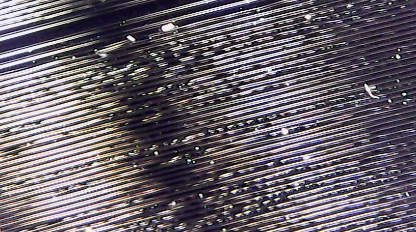
The amount of material on one side of an LP can be up to 30 minutes or 10 songs without loss of quality. The standard of five songs per side is a marketing decision and not based on physical limitations of record cutting. But this high density may cause skipping on low quality players. higher density records also provides less dead wax which may trip a unit into early shutdown.
If the playing time of an LP is around 30 minutes it does not necessarily mean poor quality at all but it does have less dead wax area and less time between songs. On a normal record the dead wax begins at 29 mm from the center hole and goes to about 70mm. On high density records music may run as close as 60 mm from center. End of record return tripping can occur before the end of the last song so either the player shuts down before the last song is done or it continues to skip back unable to overcome the slight force required to catch the return lever. Ideal return position for a player is 57mm from center but often this is not correct and sometimes not adjustable. So players with auto-return are not able to handle high density records well.
When I buy a used record at a second-hand store or garage sale I have absolutely no idea how well it plays because I can't see the wiggles, only scratches, fingerprints and center hole condition. Never mind the finger prints, beer stains, lipstick, gum, scratches and smudges. Although these are often an indicator of overall record care, they can be removed. A record may not even have a single scratch, which probably means that it’s in good shape. But it may have been played just once on a bad machine that permanently deformed the high frequency wiggles and the record has a lot of permanent hiss. Or the recording may be bad or there could be background hiss or rumble. There could be poor separation.

I get the impression that record player companies got lazy and installed tone arm mounts too close to the platter. This may have been done in order to keep record machines smaller and reduce shipping costs and also have them conform in size of other components on the market early in the hi-fi days, which included pre-amps, amps, tape decks, and receivers. This caused problems because in order to track the groove properly the tone arm was designed to overhang the turntable center which created an inward force and tended to pull the tone arm toward center. This pressure increased as the tone arm got closer to the center. If the force vector overcame the weight force that kept the stylus tracking then the result is skating” where the entire tone arm decides to take a ride to the center of your LP. Skating caused other problems too. It forced the stylus to hug the inside of the groove and sometimes you got “chatter” on the left channel outside groove. Sometimes the left channel would sputter and click, all as result of bad contact with the outer groove wall.
Another thing about stylus tracking. Study your cartridge and see how it tracks the record. I have found that it is sometimes necessary to add small paper shims to the mount to get the stylus to track properly. Over time and use the stylus could twist a bit or lose some of its shape. The standard mount allows a good deal of cartridge rotation from side to side. But if you want to make adjustments other ways you need shims.
 This
skating problem is not
all that complicated.
A lot depends on the record itself so there is simply no hard and
fast rule. I have some records that
just love to skate especially at the beginning where the record surface is
uneven. It may have to do with
groove depth. Apparently the record cutter did not
cut deep enough or the stamper was at the end of its life. If
a record is well cut then it usually is good enough to hold the stylus with or without
antiskating. Sometimes a defect
or scratch will throw the stylus out of the groove but it should bounce to the
next groove. If it skates,
increase your stylus pressure slightly and maybe increase the antiskating.
Usually the antiskating device corresponds to the stylus pressure
which does not make a lot of sense to me.
The theory is that more stylus pressure creates more inward force,
and therefore you need more outward force.
But increased stylus weight also will tend to keep the stylus in the
groove. Good records shouldn't need
any antiskating if you track at enough weight.
If you track at less than a gram, it might skate.
This
skating problem is not
all that complicated.
A lot depends on the record itself so there is simply no hard and
fast rule. I have some records that
just love to skate especially at the beginning where the record surface is
uneven. It may have to do with
groove depth. Apparently the record cutter did not
cut deep enough or the stamper was at the end of its life. If
a record is well cut then it usually is good enough to hold the stylus with or without
antiskating. Sometimes a defect
or scratch will throw the stylus out of the groove but it should bounce to the
next groove. If it skates,
increase your stylus pressure slightly and maybe increase the antiskating.
Usually the antiskating device corresponds to the stylus pressure
which does not make a lot of sense to me.
The theory is that more stylus pressure creates more inward force,
and therefore you need more outward force.
But increased stylus weight also will tend to keep the stylus in the
groove. Good records shouldn't need
any antiskating if you track at enough weight.
If you track at less than a gram, it might skate.
Another problem arose from tone arm overhang. This could cause a round stylus not to follow both groove walls evenly near the record center where the wiggles get more compressed. Look at a record and you will notice it has about two and a half times the room on the outside than it has on the inside which means the stylus travels two and a half times faster over the same time span of music. This means that the wiggles have to be that much tighter together on the inside. So designers developed elliptical and conical styluses to help solve this problem. Flattened cone shapes can track those compressed inside grooves better. But better sound is to be found on the second or third song of any album and that's a fact.
I think audiophiles get way too preoccupied with cleaning records and exaggerate the anticipated improvement in sound quality. I noticed that a few fingerprints on a record really do not seem to matter much because the oil is mostly on the top in the area between grooves and not in the groove itself and may not effect signal at all. You have much more flat surface area than groove area. But if you really like cleaning records, you can use warm water and mild detergent or the many other devices on the market. It will certainly get things cleaned up. But dust will always happen. New dust comes back within minutes. A record needs to be dusted immediately before every single play. The pictures taken above show that dust particles are everywhere.
 Hot water may warp a record but it will return to its original
shape once it cools off. Warm water is better. Water and
mild detergent removes fingerprints and just about anything else within reason
but it can leave a residue. I
once got a record that had an iron left on it. Not only was it badly
warped. but the grooves were melted on part of the record. I was able
to save the inside part.
Hot water may warp a record but it will return to its original
shape once it cools off. Warm water is better. Water and
mild detergent removes fingerprints and just about anything else within reason
but it can leave a residue. I
once got a record that had an iron left on it. Not only was it badly
warped. but the grooves were melted on part of the record. I was able
to save the inside part.
I did get some good feedback from Andy and he had suggestions on record cleaning. In his web page he says that the use of detergent is far better than hand soap or alcohol which definitely leaves residue.
There is a possibility that fingerprint oil can collect on your stylus and then you have to be especially careful when cleaning a stylus. I always dust off the record immediately before play while it is turning and before lowering my stylus. I think that’s common practice anyway. You don’t want to finish recording and find dust particles collected on the stylus.
LPs were probably the greatest thing that ever happened to the music industry and this same format was copied by the digital CD which is today out of style. The record pressings of the 70s and 80s were the best because of the use of excellent vinyl and good pressing machines. Record pressings today are not as good because the cutters have not improved. So why is it now disappearing?